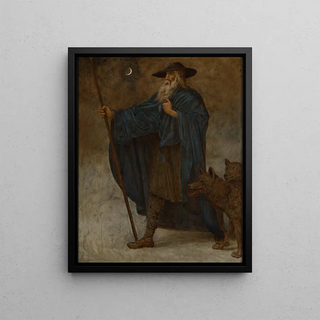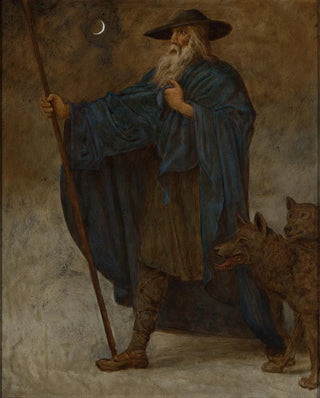Art print | December Wotan with wolves - Hans Thoma


View from behind

Frame (optional)
Art print December Wotan with wolves - Hans Thoma – Captivating introduction
In the fascinating universe of art, some works manage to transcend time and capture the collective imagination. "December Wotan with wolves" by Hans Thoma is one of those creations that evoke deep emotions and a connection with nature. This piece, imbued with mystery and poetry, immerses us in a winter landscape where the divine and the wild meet. Thoma, through his brushstrokes, invites us to explore a world where Germanic myths come to life, and where the iconic figure of Wotan, god of wisdom and war, is in harmony with wolves, symbols of savage strength. This representation reminds us of the beauty and brutality of nature, while questioning our place within this vast tableau.
Style and uniqueness of the work
Hans Thoma's style is characterized by a unique approach that combines realism and symbolism. In "December Wotan with wolves," the artist uses cool colors and delicate shades to evoke the icy atmosphere of winter. The meticulous details of the wolves, which seem almost tangible, contrast with the majestic silhouette of Wotan, creating a harmonious balance between man and animal. The composition of the piece is carefully thought out, with each element arranged to guide the viewer's eye across the landscape. Thoma manages to capture the very essence of winter, while infusing a mythological dimension into his creation. This fusion of natural and fantastical elements gives the work a depth that invites contemplation and reflection.
The artist and his influence
Hans Thoma, born in 1839, is an emblematic figure of 19th-century German art. His artistic journey is marked by a constant quest for beauty and truth, inspired by nature and popular traditions. Thoma is often considered a precursor of the symbolist movement, and his work "December Wotan with wolves" is a perfect illustration of this. By incorporating elements of Germanic mythology, he succeeds in creating a dialogue between the past and the present, while celebrating the richness of the

Matte finish

View from behind

Frame (optional)
Art print December Wotan with wolves - Hans Thoma – Captivating introduction
In the fascinating universe of art, some works manage to transcend time and capture the collective imagination. "December Wotan with wolves" by Hans Thoma is one of those creations that evoke deep emotions and a connection with nature. This piece, imbued with mystery and poetry, immerses us in a winter landscape where the divine and the wild meet. Thoma, through his brushstrokes, invites us to explore a world where Germanic myths come to life, and where the iconic figure of Wotan, god of wisdom and war, is in harmony with wolves, symbols of savage strength. This representation reminds us of the beauty and brutality of nature, while questioning our place within this vast tableau.
Style and uniqueness of the work
Hans Thoma's style is characterized by a unique approach that combines realism and symbolism. In "December Wotan with wolves," the artist uses cool colors and delicate shades to evoke the icy atmosphere of winter. The meticulous details of the wolves, which seem almost tangible, contrast with the majestic silhouette of Wotan, creating a harmonious balance between man and animal. The composition of the piece is carefully thought out, with each element arranged to guide the viewer's eye across the landscape. Thoma manages to capture the very essence of winter, while infusing a mythological dimension into his creation. This fusion of natural and fantastical elements gives the work a depth that invites contemplation and reflection.
The artist and his influence
Hans Thoma, born in 1839, is an emblematic figure of 19th-century German art. His artistic journey is marked by a constant quest for beauty and truth, inspired by nature and popular traditions. Thoma is often considered a precursor of the symbolist movement, and his work "December Wotan with wolves" is a perfect illustration of this. By incorporating elements of Germanic mythology, he succeeds in creating a dialogue between the past and the present, while celebrating the richness of the






